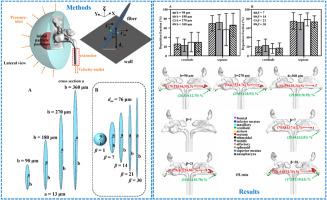Numerical analysis of Platanus orientalis L. microfiber inhalation exposure in human sinonasal cavities
IF 2.9
3区 环境科学与生态学
Q2 ENGINEERING, CHEMICAL
引用次数: 0
Abstract
Background
Postoperative Platanus orientalis L. deposition post high risk to allergen distribution in human sinonasal cavities. Due to the nature of its complex fibrous characteristics, limited research has provided a quantitative measure for accurate exposure analysis, which are critical for understanding nasal pathological and allergenic correlations.
Methods
Utilizing a complete dynamic transport model capturing both the coupled translation and rotation motion, fibrous particles deposition in 24 adult sinonasal cavity models were analyzed. The interactions between the length, aspect ratio, and airflow on fibers deposition were revealed.
Results
Fibers mainly deposited in the nasal vestibule and anterior septum. As the respiratory flow rate increases, the inhalability of fibers dominated by inertial deposition significantly increases in the nasal cavity, however with no significant change in the deposition site. As the fiber length increases, the inhalability of the fibrous particles decreases. When the diameter is the constant, the inhalability of 90 μm fibers in the nasal cavity is significantly higher than that of longer fibers. Compared to healthy individuals, more fibers can penetrate deeper into the main nasal cavity in post-Functional Endoscopic Sinus Surgery (post-FESS) nasal cases.
Conclusion
Platanus orientalis L. fibers are inertia dominated and can be inhaled into the nasal cavity with deposition mainly occur in the nasal vestibule and anterior septum, this could potentially lead to allergic rhinitis. The deposition of elongated fibers and spherical particles varies with their aerodynamic diameters. Although both healthy and post-operative nasal cavities are all subject to this inhalation exposure, post-operative individuals are more vulnerable. Research findings emphasize the need for inhalation protection for post-FESS individuals during the mature season of Platanus orientalis L. fruit.

人鼻窦内侧柏超纤维吸入暴露的数值分析
背景:术后东方伞沉积对人鼻窦内过敏原分布有较高的影响。由于其复杂的纤维特性,有限的研究为准确的暴露分析提供了定量测量,这对于理解鼻病理和过敏原的相关性至关重要。方法采用完整的动态传输模型,对24个成人鼻窦模型中纤维颗粒的沉积进行分析。揭示了长度、展弦比和气流对纤维沉积的影响。结果纤维主要沉积于鼻前庭和鼻中隔。随着呼吸流速的增加,以惯性沉积为主的纤维在鼻腔内的可吸入性显著增加,但沉积部位无明显变化。随着纤维长度的增加,纤维颗粒的可吸入性降低。当直径一定时,90 μm纤维在鼻腔内的可吸入性明显高于长度较长的纤维。与健康人相比,在功能性内窥镜鼻窦手术(后fess)鼻部病例中,更多的纤维可以深入到主鼻腔。结论东斜拉草纤维以惯性为主,可被吸入鼻腔,沉积主要发生在鼻前庭和鼻中隔,可能导致变应性鼻炎。细长纤维和球形颗粒的沉积随其气动直径而变化。尽管健康的和术后的鼻腔都受到这种吸入暴露的影响,但术后的个体更容易受到伤害。研究结果强调了在东方葵果实成熟季节对fess后个体进行吸入保护的必要性。
本文章由计算机程序翻译,如有差异,请以英文原文为准。
求助全文
约1分钟内获得全文
求助全文
来源期刊

Journal of Aerosol Science
环境科学-工程:化工
CiteScore
8.80
自引率
8.90%
发文量
127
审稿时长
35 days
期刊介绍:
Founded in 1970, the Journal of Aerosol Science considers itself the prime vehicle for the publication of original work as well as reviews related to fundamental and applied aerosol research, as well as aerosol instrumentation. Its content is directed at scientists working in engineering disciplines, as well as physics, chemistry, and environmental sciences.
The editors welcome submissions of papers describing recent experimental, numerical, and theoretical research related to the following topics:
1. Fundamental Aerosol Science.
2. Applied Aerosol Science.
3. Instrumentation & Measurement Methods.
 求助内容:
求助内容: 应助结果提醒方式:
应助结果提醒方式:


